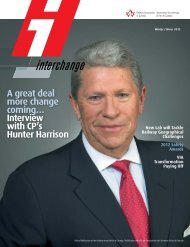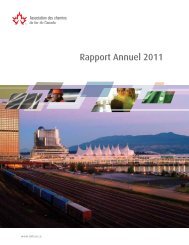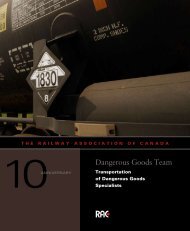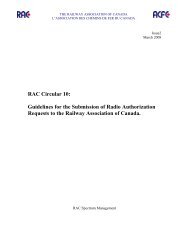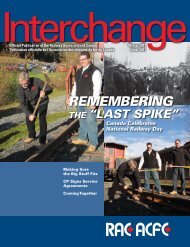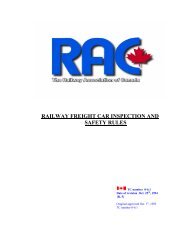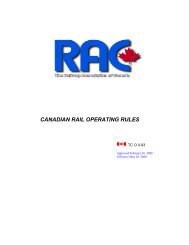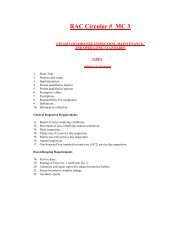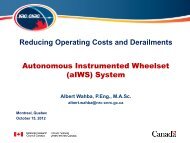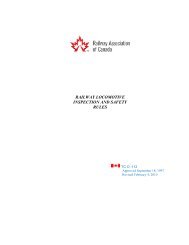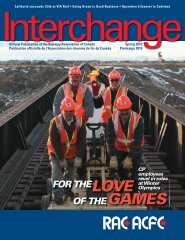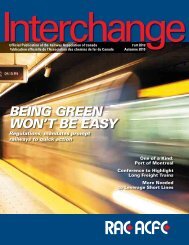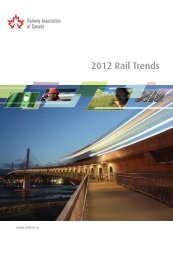Locomotive Emissions Monitoring Program - Railway Association of ...
Locomotive Emissions Monitoring Program - Railway Association of ...
Locomotive Emissions Monitoring Program - Railway Association of ...
Create successful ePaper yourself
Turn your PDF publications into a flip-book with our unique Google optimized e-Paper software.
<strong>Locomotive</strong> Utilization Pr<strong>of</strong>ile: This is the breakdown <strong>of</strong> locomotive activity within a 24-hour day (based on<br />
yearly averages).<br />
| 24-hour day |<br />
| <strong>Locomotive</strong> Available | Unavailable |<br />
| Engine Operating Time | Engine Shutdown |<br />
| Low-Idle, Idle | DB, N1 to N8 |<br />
| Duty Cycle |<br />
The elements in the above diagram constitute, respectively:<br />
<strong>Locomotive</strong> Available: This is the time, expressed in per cent <strong>of</strong> a 24-hour day that a locomotive could be used<br />
for operational service. Conversely, Unavailable is the percentage <strong>of</strong> the day that a locomotive is being serviced,<br />
repaired, remanufactured or in storage. <strong>Locomotive</strong> available time plus unavailable time equals 100 per cent;<br />
Engine Operating Time: This is the percentage <strong>of</strong> <strong>Locomotive</strong> Available time that the diesel engine is turned on.<br />
Conversely, Engine Shutdown is the percentage <strong>of</strong> <strong>Locomotive</strong> Available time that the diesel engine is turned <strong>of</strong>f;<br />
Idle: This is the per cent <strong>of</strong> the operating time that the engine is operating at idle or low-idle setting. It can be<br />
further segregated into Manned Idle (when an operating crew is on-board the locomotive) and Isolate (when<br />
the locomotive is unmanned);<br />
Duty Cycle: This is the pr<strong>of</strong>ile <strong>of</strong> the different locomotive power settings (Low-Idle, Idle, Dynamic Braking, or<br />
Notch levels 1 through 8) as percentages <strong>of</strong> Engine Operating Time.<br />
<strong>Railway</strong> Productivity Units:<br />
Gross Tonne-Kilometres (GTK): This term refers to the product <strong>of</strong> the total weight (in tonnes) <strong>of</strong> the trailing<br />
tonnage (both loaded and empty railcars) and the distance (in kilometres) the freight train travelled. It excludes<br />
the weight <strong>of</strong> locomotives pulling the trains. Units can also be expressed in gross ton-miles (GTM).<br />
Revenue Tonne-Kilometres (RTK): This term refers to the product <strong>of</strong> the weight (in tonnes) <strong>of</strong> revenue<br />
commodities handled and the distance (in kilometres) transported. It excludes the tonne-kilometres involved<br />
in the movement <strong>of</strong> railway materials or any other non-revenue movement. The units can also be expressed in<br />
revenue ton-miles (RTM).<br />
Passenger-Kilometres per Train-Kilometre: This term is a measure <strong>of</strong> intercity train efficiency, that is, the<br />
average <strong>of</strong> all revenue passenger kilometres travelled divided by the average <strong>of</strong> all train kilometres operated.<br />
Revenue Passenger-Kilometres (RPK): The total <strong>of</strong> the number <strong>of</strong> revenue passengers multiplied by the distance (in<br />
kilometres) the passengers were transported. The units can also be expressed in revenue passenger-miles (RPM).<br />
vii LEM 2008




